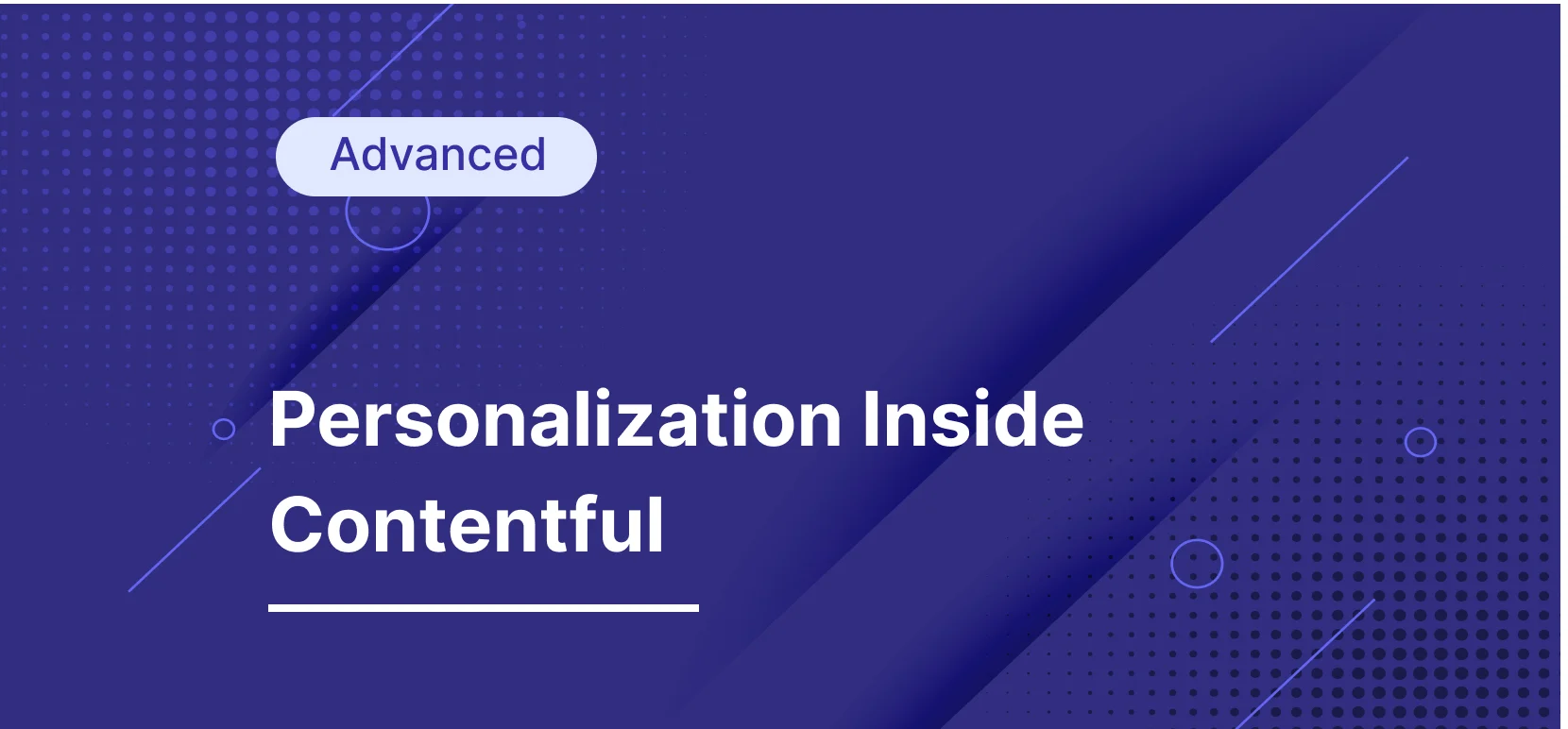- Personalization
Personalization in Banking: How to Gain a Competitive Edge


Everyone's financial situation is unique — but too often, banks treat customers like they're all alike. If your bank isn't using personalization, you aren't showing your customers that you understand who they are and what they need.
Customers expect and welcome personalized offers and recommendations. In a survey of over 2,000 banking customers in North America, 72% said they consider product recommendations to be more valuable when personalized. And, they’re willing to provide and allow the use of their personal data in exchange.
In this guide, learn all about personalization in banking, its benefits and opportunities, and how to successfully implement it across your digital touchpoints.
What Is Personalization in Banking?
Personalization in banking is the practice of using customer data to predict, inform, craft, and deliver customized interactions. It enables your company to present messaging, services, and experiences on your digital channels that meet the unique needs and preferences of each customer.
When done well, it’s like having a personal banker in your pocket who knows exactly what you need, when you need it.
Examples of Banks Using Personalization
Tailored offers and recommendations: Banks can analyze spending habits to suggest relevant products, such as credit cards with higher rewards for frequent travelers or savings accounts with better interest rates for consistent savers.
Personalized financial advice: AI-driven insights can provide tailored advice based on individual financial goals and circumstances, helping customers manage their budgets, investments, and savings plans better.
Targeted communication: Whether it's email, SMS, or app notifications, personalized messages ensure customers receive timely and relevant updates, like reminders to pay bills or alerts about upcoming investment opportunities.
Enhanced customer support: Through personalized chatbots and virtual assistants, banks can offer faster and more efficient support, addressing specific customer inquiries and issues based on their account history and preferences.
Seamless omnichannel experience: Personalization ensures a consistent experience across all channels, from mobile apps to online banking portals, making it easier for customers to switch between devices without losing context.
Benefits for Financial Institutions
Personalization is mutually beneficial for you and your customers. It increases trust and satisfaction for your customers by proving that you understand their needs at any given time. In return, banks earn increased customer acquisition, retention, and revenue growth.
Findings from a McKinsey survey revealed that personalization can help you:
Reduce customer acquisition costs by up to 50%
Increase revenue by 5-15%
Increase marketing ROI by 10-30%
Outcomes of Personalization in Banking
Personalization allows banks to make customized product recommendations and strategically cross sell relevant products to their customers. A basic personalization strategy and investment can deliver a mild boost in business growth. But, an advanced approach can produce exponential returns.
Advanced personalization — tailoring content and experiences to specific customer segments — can increase conversions for the financial services industry by nearly 28%. That’s compared to a 2% increase for companies that deliver basic personalization.
Furthermore, banks that adopt advanced personalization tactics have a significant competitive edge. Less than a third of the industry are leveraging advanced personalization. So by embracing it, you can outperform competitors and create better customer experiences, which is critical at a time when consumers have so many choices.
Challenges in Implementation
Implementing digital personalization in banking comes with its own set of challenges, primarily revolving around customer data.
Customer Trust
Banks need to be careful to ensure that their use of personal data doesn't come across as intrusive or invasive. Many customers are wary of how their data is being used, especially by financial institutions that hold very sensitive information on their customers. Any missteps can lead to a serious breach of trust.
Limited Resources to Develop Personalization Systems and Technology
Implementing personalization effectively requires that your staff can manage or develop the necessary software. Legacy solutions — the tools your team is already using for personalization — may depend on developers to execute campaigns and segmentation. Not all banks have the bandwidth on their team to handle that or the budget to outsource developers.
Beyond the technical side, banks may not have the expertise or capacity within their marketing or customer experience staff to properly execute and scale personalization methods. A little over a third of banks surveyed believe they have enough staff to achieve personalization goals, and only 24% are confident their team has the necessary skills and expertise.
With Ninetailed, you don’t need that developer expertise and experience. Implementation is fast and easy. The team at home interior brand Ruggable was able to begin creating personalized experiences like messaging and website banners in under an hour. With its intuitive interface and AI-powered recommendations, even marketing teams with less personalization experience can learn skills and execute campaigns quickly.
Effective and Accurate Data Management
Another problem is data collection, quality, and management. Banks handle vast amounts of data from various sources, and integrating this information into a cohesive and accurate customer profile can be complex. Some banks may have customer data scattered across different departments and tools, leading to incomplete and siloed data.
Inaccurate or outdated data can cause personalized communication that’s irrelevant or off-putting, which may frustrate customers and erode trust.
Best Practices in Banking Personalization
To deliver the best personalized experiences for your customers and earn their trust while achieving the best results, focus on these priorities for your strategy.
Prioritize Privacy
Privacy is a top concern among banking customers, so you must be transparent about data practices and ensure top security measures for personalization purposes. Allow customers to customize what data they share with you, and clearly communicate what benefits they get in exchange.This is a way to build trust and demonstrate that personalization is not just about selling products but about enhancing the overall banking experience.
Define and Track Goals
Understand what you need out of adding personalization to your toolkit. Do you need to increase customer acquisition? Gain momentum for new products and services? Win back inactive customers? Improve customer engagement and overall experience?
Once you’ve determined what your primary goals are, regularly track your results and performance against them. This will reveal what’s working and where you can improve so you can optimize your strategy going forward.
Strategically Segment Your Customers
By segmenting your audience into different groups based on their stage in the customer journey, user behavior and preferences, demographic information, and more, you can reach them at the right moments with the right messages. Here are the top ways that high-performing financial companies are segmenting customers based on a Ninetailed report:
Firmographic: This approach divides audiences based on company size, industry, and financial performance. It's particularly useful for B2B fintech companies, allowing them to create tailored offers for specific accounts with high conversion potential.
Behavioral: By analyzing how customers use existing products, companies can create targeted offers and adjust messaging according to the customer’s stage in the buyer journey. This is crucial, as many financial services customers need multiple touchpoints before making a decision.
Device type: The device a customer uses (mobile or desktop) provides insights into their content preferences. Financial services companies use this information to tailor content, advertisements, and experiences to match the preferred consumption method of their audience.
Referrer-based: Understanding where a customer heard about a product – like through word-of-mouth or affiliate marketing – helps companies position their products effectively and align messaging with the source of the referral.
Page visit: By tracking which pages customers visit, financial services companies can tailor their messaging and offers to the specific interests and needs of potential buyers, providing relevant, timely information to build trust and reinforce the brand.
Test Different Tactics and Messaging
To get personalization right, improve performance, and scale your program, you need to test different campaign elements and channels. You can test different factors like content types and language, posting and delivery times, email subject lines, CTAs, pricing, product recommendations, and channels.
By using A/B testing, you can compare different variables to determine which ones are most impactful. Continuous testing helps in optimizing current campaigns while also providing valuable insights into customer preferences and behaviors. This data-driven approach ensures that personalization efforts are effective, relevant, and aligned with customer needs.
Provide Financial Guidance and Education
Be careful to not lean too heavily on using personalization to sell. Beyond offering relevant product recommendations and offers, provide educational content that will guide and advise customers. This shows them you care and have their best interests in mind.
This type of personalized content based on each customer’s financial position isn’t just helpful, but sought after. Financial health support and assistance is very important, especially for 65% of Gen Z customers and 61% of Millennial customers. Create resources that provide tips and best practices for financial management and what customers need to know to reach their next milestone.
Invest in the Right Personalization Technology
Selecting and implementing a top notch personalization solution is a game-changer for collecting and managing accurate, up to date data and creating and delivering campaigns based on that data. Do your research to find a tool that overcomes your challenges and meets your needs.
Features to look for are strong security, real-time data capture and organization, AI-assisted segmentation and campaign recommendations, A/B testing, and performance tracking. Bonus if the tool doesn’t require technical or developer expertise. An all-in-one, no-code, or low-code solution makes it easy for your existing team to use.
Why Ninetailed Is the Best Tool for Personalization in Banking
Ninetailed offers advanced data analytics, seamless integration with your current tech stack, and a user-friendly interface. It empowers banks to create highly targeted and relevant customer experiences across all digital channels. With Ninetailed, banks can efficiently segment their audience, conduct robust A/B testing, and gain actionable insights to continuously optimize their personalization strategies.
Get in touch to start creating composable personalization within your content workflow. In minutes
